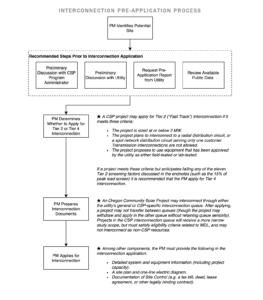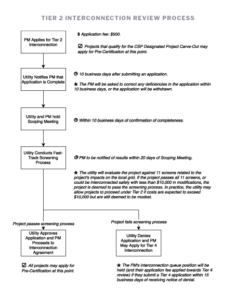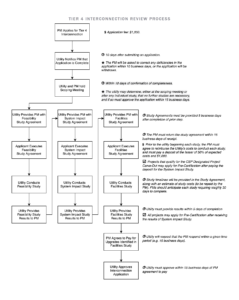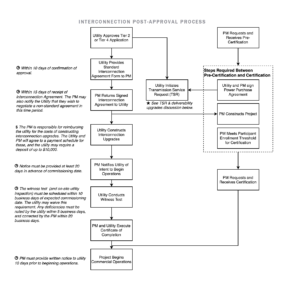Interconnection
Projects participating in the Oregon Community Solar Program must receive approval through their electric utility to interconnect to the distribution grid. Community Solar Projects will interconnect through either Tier 2 or Tier 4 review under the processes defined in the Oregon Small Generator Interconnection Rules (OAR 860-082).
Each utility has developed a dedicated interconnection process for Community Solar projects, which is open to projects that intend to participate in the Community Solar Program and are sized to be less than the Minimum Daytime Load (MDL) (net of existing and proposed generation) of the distribution feeder to which they would interconnect. Portland General Electric and Pacific Power have established a separate queue for eligible Oregon Community Solar projects, and Idaho Power processes these projects within their general queue but tracks them separately. Community Solar projects are not required to apply through this dedicated interconnection queue and may apply through the standard interconnection queue if they prefer.
Projects that apply to their utility’s CSP-specific interconnection queue will be studied by their utility through a narrower scope than projects in the general interconnection queue. In the general interconnection queue, a utility will study a project as a network resource and will assess the necessary costs both to connect the generator to the distribution grid and to deliver the power to load. In contrast, a project applying through a utility’s CSP-specific interconnection queue will be studied as an energy resource, with the utility considering only the costs necessary to connect the generator to the electric grid.
CSP project managers should take care in identifying a project site and in proposing a size for their project, as these can dramatically impact the types of upgrades and improvements that are necessary to interconnect a project to the electric grid.
Project managers are responsible for paying the costs of any upgrades necessary to safely interconnect a project, and proper siting and sizing decisions can help to minimize these costs.
The following recommendations are provided to project managers to mitigate the risk of requiring extensive upgrades.
Site your project in a location that minimizes expected upgrade costs.
Regardless of size, Community Solar projects located in certain areas are likely to encounter challenges and high cost estimates in the interconnection process. It is recommended that project managers take the following into account in their initial siting decisions:
- Project managers should pursue sites that are located on distribution circuits with adequate load to accommodate a project. Each utility has published data regarding the Minimum Daytime Load (MDL) of distribution circuits within their service area (see links to Distribution System Data in the Resources section below). To qualify for a utility’s CSP interconnection queue, a project must be located on a circuit where the posted MDL exceeds the project’s capacity in AC (as well as the cumulative capacity of all existing or higher-queued proposed resources). As noted below, there are additional factors that may require a project to be sized conservatively relative to MDL to avoid costly interconnection upgrades. As an initial site screening criteria, project managers should identify and pursue sites that would interconnect to distribution feeders that have more than enough load to accommodate the generation of a Community Solar Project. If a project manager is unsure which distribution feeder would serve a potential site, utility interconnection staff are able to provide this information without a formal application. Project managers should request this information from the designated points of contact provided by each utility on their interconnection websites (see links to utility interconnection webpages in the Resources section below).
- Projects should be located as close to the substation as possible and without a recloser present between the project and the substation. The further away a project is located from the substation, the higher the likelihood that a recloser will be present between the project and the substation. If a recloser is located upstream of a project on the distribution circuit, the project must install a transfer trip and other upgrades if the generating capacity of the project exceeds the MDL of the distribution line section downstream of the recloser (as opposed to the MDL of the entire distribution circuit). Projects located further from substations may also receive higher cost estimates due to increased costs of running any required fiber or similar improvements. Project managers are encouraged both to attempt to site their projects close to substations and also to confirm with utility interconnection staff early on whether a recloser is present between the project site and the substation.
- Projects should interconnect to areas served by a three-phase line. If a project proposes to connect to a location with single-phase power, it may be required to pay for upgrades to three-phase power. Project managers should confirm with utility interconnection staff whether the site is served by a three-phase or single-phase line.
- Project managers should be aware of additional location-specific challenges that are present in certain areas of the state. Utilities may provide additional information on specific areas of the grid where interconnection may be challenging or create additional expense. Of note, Pacific Power has reported that significant transmission upgrades may be required to accommodate new generation in certain parts of its service area, especially in but not limited to Northeastern Oregon. It is currently unresolved whether a Community Solar Project located in those areas would be required to contribute to these costs, but project managers proposing to develop in these areas should be aware of this issue. This issue is discussed more in the Power Deliverability Upgrade Costs section below.
Once a site is identified, size your Community Solar project conservatively to mitigate the need for and cost of improvements.
While the distribution data posted by each utility is a helpful tool in understanding the feasibility of interconnecting to a given circuit and determining the maximum project size that can apply to a utility CSP interconnection queue, there is often more complexity involved in determining how large of a project may be accommodated without requiring upgrades. It is recommended that project managers mitigate their risk by taking the following steps:
- Project managers should understand that MDL values may change and should confirm these values with utility staff early on. While each utility has posted their best understanding of MDL values for circuits across their distribution system, these values are subject to change based on consultations with utility area engineers during the interconnection study process. Project managers are encouraged to discuss the best known data with utility interconnection staff early in the interconnection process and may wish to size their projects below posted the MDL values to mitigate this risk.
- Projects should be sized no larger than 90% of the distribution circuit’s MDL. If a project exceeds MDL, it may be required to install a transfer trip, which can add significantly to project expense. To provide a safety margin, utilities will generally require this equipment if a project’s capacity exceeds 90% of MDL. Projects can mitigate their risk of interconnection costs by sizing below this 90% safety buffer.
- Projects should be sized smaller than 3 MW-AC. Community Solar Projects are permitted to be sized up to and including 3 MW-AC. Under OAR 860 interconnection rules, projects sized 3 MW or larger may be required to pay for telemetry equipment as part of an interconnection package. While smaller projects may still be required to pay these costs in some cases, this risk can be mitigated by sizing the project slightly less than 3 MW.
Understand your utility’s minimum interconnection package.
As all Community Solar projects are installed in-front of the meter (unlike Net Energy Metering projects), project managers should anticipate that their project will be required to fund a minimum basic package of interconnection improvements to allow their project to be connected to the grid and metered. In Pacific Power service area, project managers should expect to be quoted a minimum interconnection improvement cost of roughly $50,000. Project managers that plan to develop small projects should take this into account and confirm this with utility interconnection staff early in the process.
Take advantage of the Scoping Meeting convened by the utility at the start of the interconnection review process.
While the above guidance on siting and siting can be helpful in reducing the cost of interconnection, the impacts of each project will be assessed individually by utilities and project managers should be sure to discuss and understand all project-specific details with their utility. Utilities will convene a Scoping Meeting with the project manager and key utility interconnection staff before conducting a Tier 2 or Tier 4 interconnection study. At this early stage of the review process, project managers may have some flexibility in adjusting their proposed system design, and they should take advantage of the opportunity to discuss potential issues and alternatives with utility staff. If a project manager lacks the subject matter expertise to have an informed technical conversation at this meeting, they may wish to retain an interconnection expert to accompany them (these project managers should refer to Community Solar Development Assistance under Resources). Suggested topics to confirm with utility staff at this meeting include:
- Confirming the utility’s best understanding of the Minimum Daytime Load assumptions for the distribution feeder that will be used in the interconnection study.
- Confirming the utility’s best understanding of the system capacity threshold that would trigger the need to install protective schemes, such as transfer trip.
- For small projects, confirming the cost of the minimum base package of interconnection upgrades necessary to interconnect a project of that size (assuming that no issues are uncovered in the interconnection review).
- Confirming whether there is a recloser present on the distribution feeder between the project site and the substation, and if so confirming the expected MDL of portion of the distribution circuit downstream of the recloser.
- Confirming whether a site is served by a three-phase or single-phase line.
- Confirming whether there are alternative points of interconnection to the same circuit or to a different circuit that may allow for an easier interconnection.
- Confirming whether the project is located in a load pocket or other area where there are known or uncertain deliverability issues.
- Confirming the process, timeline, and expected costs for all steps in the interconnection process.
Project managers are encouraged to have conversations with both utility interconnection staff and the Community Solar Program Administrator prior to applying for interconnection to ensure they have the most up-to-date information regarding the interconnection process and are aware of any specific circumstances in their desired area. Project managers are also encouraged to request a pre-application report from their utility, which will provide prior study results and other known data for the distribution area of interest. These pre-application reports are typically available from utilities for a fee (Pacific Power charges a $300 fee for a pre-application report, for example), but non-profit or public sector organizations that are registered project managers in the Oregon Community Solar Program may request up to five pre-application reports from their utility at no cost.
The flowchart below indicates the key steps that a project manager should pursue prior to applying for interconnection with their utility, as well as factors to consider in whether to file for Tier 2 or Tier 4 review, and whether to apply to the utility’s general interconnection queue or CSP interconnection queue. Subsequent flowcharts indicate the process for obtaining Tier 2 Review, Tier 4 Review, and for completing steps that follow interconnection application approval. In developing an interconnection timeline, project managers should expect that utilities will utilize the full amount of review time allowed to them in each step. This information is provided only to provide a sense of the process to project managers, and project managers are responsible for confirming all interconnection steps, costs, requirements, and timelines with their utility.
If a project manager requests Tier 2 review, the utility will conduct a study that evaluates the project against a series of 11 screening factors that will determine whether the project is likely to have negative impacts on the grid. The utility will approve the project application if the project passes all screens, and otherwise will require the project manager to apply for Tier 4 review.
The screening factors (“Approval Criteria”) that the utility will use to evaluate the project in Tier 2 review are provided in OAR 860-082-0050 (2).
If a project manager requests Tier 4 review, the project will be studied through a series of three successive tests:
- The Feasibility Study provides a preliminary assessment of the potential impacts of the generator on the utility distribution and transmission system; it may consider multiple possible points of interconnection to assess alternatives. In practice, utilities and projects often agree to waive this study and proceed directly to System Impact Study. Projects applying through their utility’s CSP interconnection queue will not receive a Feasibility Study and will proceed directly to the System Impact Study.
- The System Impact Study provides a more in-depth assessment of the impacts of the generator on the distribution and transmission grid if no modifications are made; it entails a much more detailed technical analysis than the feasibility study and also identifies the modifications that may be required to accommodate the generator.
- The Facilities Study builds on the System Impact Study and provides a more detailed description of the specific facilities and modifications that are required to safely interconnect a generator, as well as the expected cost and timeline of these improvements.
In advance of each successive study, the utility and project manager will sign a study agreement that details the scope of the study. The project manager is required to reimburse the utility for the costs of conducting the study (which will be projected in the study agreement) and must pay a deposit towards these costs prior to the utility beginning the study.
After an application is approved by the utility (either through Tier 2 or Tier 4 review), the project manager must complete a series of steps before making the project operational. The project manager must also complete certain steps within the Oregon Community Solar Program around this time. Some of the key milestones are:
- The project manager and utility will sign an Interconnection Agreement that lays out the specific upgrades that the utility will construct, their cost, and the expected timing. Once this document is signed, the costs and timeline are generally locked in, so project managers should ensure they are comfortable with these before signing.
- The project manager may request project pre-certification in the Oregon Community Solar Program after reaching a certain stage in the interconnection review process (as noted in the Tier 2 and Tier 4 diagrams above). Project managers must also satisfy other project development criteria, such as obtaining a Conditional Use Permit if required, before applying for pre-certification. Project managers should refer to the Program Implementation Manual for a full list of pre-certification requirements.
- A pre-certified project may sign a Power Purchase Agreement (PPA) with the utility. Once a PPA has been signed and an interconnection application has been approved, the utility will file a Transmission Service Request (TSR) on behalf of the project. The TSR is further discussed in the Power Deliverability Upgrade Costs section of this guidance.
- A project manager may commence construction of the project after it has been pre-certified (practically, a project manager should secure an Interconnection Agreement before constructing). The utility will construct interconnection upgrades after the Interconnection Agreement is signed. Note that utility timelines for constructing upgrades may be as long as 12 to 18 months.
- After a pre-certified project has signed a PPA, been fully constructed, and met participant enrollment thresholds, it may request project certification through the Oregon Community Solar Program. Project managers should refer to the Program Implementation Manual for a full list of certification requirements.
- A project may commence commercial operations after it has been certified through the Community Solar Program and has fully completed the interconnection process, including executing a Certificate of Completion with the utility.
This section provides guidance on potential transmission upgrades that may be identified for certain Community Solar projects. This is a developing issue, and this information will be updated as more is known about deliverability upgrade needs and the allocation of associated costs. At this time, this issue is only known to impact projects located in Pacific Power service area in Eastern and Southern Oregon. Project managers should discuss this issue in early conversations with their utility and the Community Solar Program administrator to receive up-to-date information and understand how this may impact their project.
As noted above, projects applying through a utility CSP-specific interconnection queue will be evaluated as energy resources, which will not consider upgrades required to ensure the deliverability of generated power to load. However, utilities must still ensure that power may be safely delivered to network load through the Transmission Service Request (TSR) process. This process may uncover the need for additional upgrades and costs associated with delivering the power of a CSP project to load under certain conditions. If that occurs, the utility would bring the issue to the attention of the Oregon Public Utility Commission, who would be responsible for determining how these costs would be met. As this has not yet occurred for any CSP project as of this writing, the cost responsibility for these deliverability costs is not settled.
To provide visibility into the potential need for deliverability upgrades, utilities may conduct an information-only network resource study along with the project’s Tier 2 Screening Study or Tier 4 System Impact Study. This information-only network resource report will provide project managers with an estimate of potential deliverability costs, but this report will be non-binding and project managers will not be required to pay the deliverability upgrade costs identified.
Given the uncertainty posed by these potential costs, it is recommended that project managers work with their utility to file a Transmission Service Request (TSR) as early as possible in the process so that these costs may be identified and addressed. Before filing a TSR, the utility must have approved an interconnection application and the project manager must have signed a Power Purchase Agreement (which in turn requires that the project be pre-certified by the Oregon Community Solar Program). To make this process as streamlined as possible, project managers should request pre-certification as soon as they meet program requirements and should sign a CSP PPA with the utility soon after becoming pre-certified. Project managers who have been informed by their utility that their project may trigger deliverability upgrades are also advised to delay signing any participant contracts while the issue of deliverability costs is being addressed, because of the impact that this process may have on project development.
- Oregon Administrative Rules for Small Generator Interconnection (OAR 860-082). These rules govern the processes for Tier 2 and Tier 4 interconnection, which apply to Oregon Community Solar projects.
- Energy Trust Interconnection Guidebook. This resource provides additional information and interpretation of the Small Generation Interconnection administrative rules (which are referred to in the guidebook as AR 521 procedures).
- Utility Interconnection Websites. Each utility provides a website with links and instructions for beginning the interconnection process. Each webpage designates the utility interconnection staff that will serve as the primary point of contact for interconnection questions.
- Utility OASIS Web Portals. Each utility maintains an OASIS web portal that hosts interconnection queues, distribution system data, and past interconnection study results, all of which is helpful information for project managers to review.
- PGE OASIS site
- General Interconnection Queue Location: Navigate to “Generation Interconnection” → “Oregon Small Generator Interconnection” → “Interconnection Queues”→ “Small Generator Queue”
- CSP Interconnection Queue Location: Navigate to “Generation Interconnection” → “Oregon Small Generator Interconnection” → “Interconnection Queues” → “Community Solar Queue”
- Past Interconnection Study Reports: Navigate to “Generation Interconnection” → “Oregon Small Generator Interconnection” → “Study Reports” (refer to CSP or General Interconnection Queue to identify reports of interest)
- Distribution System Data (Includes MDL and proposed generation by feeder): Navigate to “Generation Interconnection” → “Oregon Small Generator Interconnection” → “Additional Information” -> “PGE Distribution System Data”
- PAC OASIS site
- General Interconnection Queue Location: Navigate to “Generation Interconnection and TSR Queues” → “Generation Interconnection” → “Generation Interconnection Queue” -> “Generation Interconnection Queue”
- CSP Interconnection Queue Location: Navigate to “Generation Interconnection and TSR Queues” → “Generation Interconnection” → “Oregon Community Solar” → “Oregon CSP Interconnection Queue”
- Past Interconnection Study Reports: Hyperlinked within the CSP and General Interconnection Queue documents
- Distribution System Data (Includes MDL and proposed generation by feeder): Navigate to “Generation Interconnection and TSR Queues” → “Generation Interconnection” → “Additional Information” → “Oregon UM 2000 Distribution Data”
- IPC OASIS site
- General Interconnection Queue Location: Navigate to “Generation Interconnection” →“Oregon Interconnection Queue” → “Oregon Interconnection Queue”
- CSP Interconnection Queue Location: Listed within General Interconnection Queue
- Past Interconnection Study Reports: Navigate to “Generation Interconnection” → “Oregon Interconnection Queue” → “Oregon Redacted Study Reports” (refer to Interconnection Queue to identify reports of interest)
- Distribution System Data (Includes MDL and proposed generation by feeder): Navigate to “Generation Interconnection” → “Oregon Interconnection Queue” → “Additional Info.” → “UM 2000 data”
- PGE OASIS site
- Utility Tariff Schedules. Each utility has developed a tariff schedule which governs Community Solar projects, and which includes important information regarding interconnection and Power Purchase Agreements.
- Relevant OPUC Orders. Two orders from the Oregon Public Utility Commission relate to the interconnection process for community solar projects:
- Order 19-392 – November 2019. This order provides guidance and rationale for the development of specific interconnection measures for the program.
- Order 20-038 – February 2020. This order provides detailed instruction to utilities in creating and managing the dedicated community solar interconnection queue.
Resources
Community Solar Development Assistance
Energy Trust of Oregon provides a limited amount of development funding to small projects and projects led by public or non-profit project managers that intend to participate in the Oregon Community Solar Program. This funding can be used for a variety of early-stage project planning activities, including funding staff time or third-party services related to interconnection. More information on this funding opportunity is available here.




